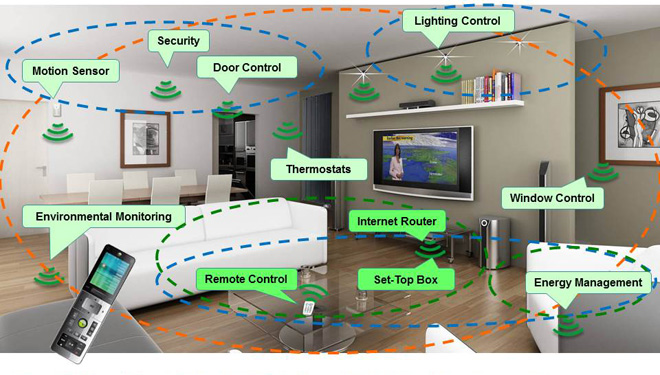The first documentation of ‘Internet of Things’ was made in 1999 by Kevin Ashton, a British technologist working with MIT. Since then a great deal has been written and disputed about the possibilities, opportunities and threats of this vision of the future and, in the meantime, the future has very much become the present and the past.
The internet of things is upon us; even today our homes are substantially more connected than they were twenty or even fifteen years ago. Life without Wi-Fi is something anyone past school leaving age can remember. Even five years ago, the only things connected to our home’s ‘central hub’ were things such as PCs, laptops, smart phones, printers and games consoles.
Automation, until recently, was crude and rudimentary. Examples include the timers on thermostats and boilers, an elderly person’s chairlift or perhaps a coffee maker that could be programmed to turn on fifteen minutes before your alarm. For most there was certainly nothing that could be regarded as high tech cutting edge and gadgets were certainly not centrally controlled, interconnected or part of what one might deem a network of things.

Jump forward to the present day however, and this has all changed. We are in the midst of a rising tide of smart home automation, powered by the Internet of Things. Security, convenience and energy efficiency are increasingly connected and watched over by the home’s central hub.
CCTV, digital locking and interactive alerting systems are capable of protecting your home around the clock and keeping you up to date with live information via your smart phone.
Smart heating systems are capable of learning your routines and habits, can use geofencing technology and even monitor the weather to ensure your home is heated or cooled efficiently.
Fridges are capable of keeping stock of their contents, beds can monitor how you breath and move at night in order to give you advice on how to sleep better and sound systems will switch on or off as you wake, come home or leave for the day.
The most important aspect of all these devices is that they are becoming ever more interconnected. They report back to your smart phone or a central hub and operate completely over your home’s Wi-Fi network. As a result, cutting edge smart home devices are capable of learning about you and about each other in order to maximize your comfort and security whilst keeping your environmental footprint as low as possible.
A leading factor in the advent of smart homes is the falling cost of smart home devices. Whilst the cost of devices can vary quite drastically across the globe, the fact that they are becoming more affordable is ensuring they develop into increasingly attractive purchases for consumers. Some of the latest smart home hubs, capable of controlling everything from your home’s central heating to the music it plays, are available for somewhere around £250.
A secondary factor is the fact that, individually, many ‘smart’ devices have actually been around for several years. The difference is, when connected to a network of other devices (i.e. your home’s Internet of Things) they become far more effective, easy to integrate and simple to use. As a result, consumers who would not usually consider themselves first adapters of new technology are being drawn into purchasing smart home devices in vast numbers, adding to their widespread appeal.
There are several concerns about this ubiquitous computing, notably around privacy, security and overly exposing children to technology at an early age. Challenges facing developers are to address such concerns and ensure technology is not intrusive, data is extremely well protected and there are safeguards in place that allow parents to control how much and the type of exposure children receive to technology in the home.
On the other side of the coin, many advocators of the Internet of Things point to the incredible opportunities that having all these interconnected devices. Whilst ‘Big Data’ is a term that is widely used and not particularly well understood at the moment, having the opportunity to analyse the patterns and habits of our families’ lives is one that excites scientists and experts across a broad range of fields. Whilst there are certainly opportunities for companies to use our data for things such as targeted marketing, the possibilities for good are seemingly endless. Better security, lower energy usage and a more comfortable home are just the start of what the IoT could do for you.